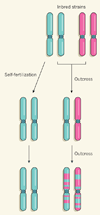Genetics: Feedforward loop for diversity
- PMID: 26176917
- PMCID: PMC4965165
- DOI: 10.1038/nature14634
Genetics: Feedforward loop for diversity
Abstract
DNA-sequence analysis suggests that genetic mutations arise at elevated rates in genomes harbouring high levels of heterozygosity — the state in which the two copies of a genetic region contain sequence differences.
Figures

Comment on
-
Parent-progeny sequencing indicates higher mutation rates in heterozygotes.Nature. 2015 Jul 23;523(7561):463-7. doi: 10.1038/nature14649. Epub 2015 Jul 15. Nature. 2015. PMID: 26176923
Similar articles
-
Parent-progeny sequencing indicates higher mutation rates in heterozygotes.Nature. 2015 Jul 23;523(7561):463-7. doi: 10.1038/nature14649. Epub 2015 Jul 15. Nature. 2015. PMID: 26176923
-
[Effect of mutant genes with a known biochemical effect on the rate of conditioned motor reflex formation in honey bees].Zh Vyssh Nerv Deiat Im I P Pavlova. 1980 Jul-Aug;30(4):761-4. Zh Vyssh Nerv Deiat Im I P Pavlova. 1980. PMID: 7434949 Russian.
-
Allozyme variation in bumble bees (Hymenoptera: Apidae).Biochem Genet. 1992 Oct;30(9-10):443-53. doi: 10.1007/BF01037585. Biochem Genet. 1992. PMID: 1445186
-
Comparative biology comes into bloom: genomic and genetic comparison of flowering pathways in rice and Arabidopsis.Curr Opin Plant Biol. 2003 Apr;6(2):113-20. doi: 10.1016/s1369-5266(03)00014-1. Curr Opin Plant Biol. 2003. PMID: 12667866 Review.
-
The molecular basis of diversity in the photoperiodic flowering responses of Arabidopsis and rice.Plant Physiol. 2004 Jun;135(2):677-84. doi: 10.1104/pp.104.042614. Plant Physiol. 2004. PMID: 15208414 Free PMC article. Review. No abstract available.
Cited by
-
Direct Determination of the Mutation Rate in the Bumblebee Reveals Evidence for Weak Recombination-Associated Mutation and an Approximate Rate Constancy in Insects.Mol Biol Evol. 2017 Jan;34(1):119-130. doi: 10.1093/molbev/msw226. Epub 2016 Oct 20. Mol Biol Evol. 2017. PMID: 28007973 Free PMC article.
-
Global allele polymorphism indicates a high rate of allele genesis at a locus under balancing selection.Heredity (Edinb). 2021 Jan;126(1):163-177. doi: 10.1038/s41437-020-00358-w. Epub 2020 Aug 27. Heredity (Edinb). 2021. PMID: 32855546 Free PMC article.
-
Natural Selection and Recombination Rate Variation Shape Nucleotide Polymorphism Across the Genomes of Three Related Populus Species.Genetics. 2016 Mar;202(3):1185-200. doi: 10.1534/genetics.115.183152. Epub 2015 Dec 31. Genetics. 2016. PMID: 26721855 Free PMC article.
-
Contrasting Sex-and Caste-Dependent piRNA Profiles in the Transposon Depleted Haplodiploid Honeybee Apis mellifera.Genome Biol Evol. 2017 May 1;9(5):1341-1356. doi: 10.1093/gbe/evx087. Genome Biol Evol. 2017. PMID: 28472327 Free PMC article.
References
-
- Foster PL. Genes Genomes Genet. 2013;3:399–407. - PubMed
Publication types
MeSH terms
Grants and funding
LinkOut - more resources
Full Text Sources
Other Literature Sources

